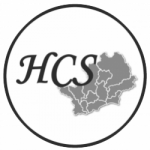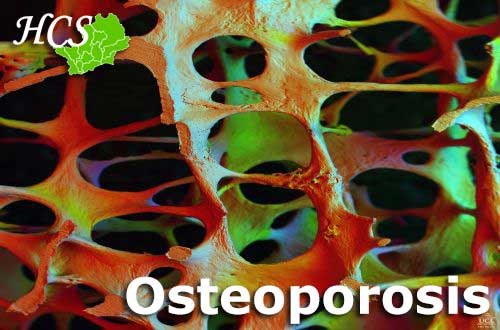Osteoporosis
Osteoporosis is a condition that affects the structure of bones as we age. Healthy young bone is rather like the inside of a Crunchie bar – a dense network of solid material around lots of tiny holes. As we age, the holes get bigger and the solid material shrinks – more like an Aero! Eventually, the density falls so low that bones become weak and liable to fracture easily: this is osteoporosis. The size and shape of bone also contributes to risk of fracture.
People who have large, dense bones in middle-age can weather age-related bone loss without reaching the critically low levels that define osteoporosis. The challenge we face is to ensure that as many people as possible reach middle age with such healthy bones.
Research into osteoporosis needs state-of-the-art images of bone that show its size, shape and structure in great detail – and these images need to be repeated to examine changes over time. With this in mind, many of the HCS participants have had their bones studied in great detail using a range of techniques such as x-rays, DXA, pQCT and high resolution pQCT scanning (see the ‘Key Findings’ section on ‘Bone Imaging Techniques’ for more detail).
Work in Hertfordshire has demonstrated that influences acting before birth and in infancy affect later bone health:
- Men and women who were bigger at birth and at one year of age had bigger, denser bones in later life.
- Infant growth affects the shape of bones as well; smaller babies grew up to have more vulnerable hip joints than bigger babies, due to differences in the shape of their leg-bone.
- pQCT scans can estimate the amount of stress a bone could withstand before breaking. We used these scans to show that people who were bigger at birth and at age one had stronger bones.
- Using DNA from blood tests, we showed that genetic differences in the way we handle Vitamin D affect bone density more in babies who are small at birth than in bigger ones. This is important because people who have low levels of Vitamin D are more likely to fracture than those whose levels are high.
This suggests that in order to improve bone health in future generations of older people, we need to act while they’re young – or even before they’re born. We are carrying out trials in pregnant women to see if taking vitamin D supplements strengthens their babies’ bones. If it does, we expect supplementation to become a standard part of maternity care.
Reference List
Zhang J, Parsons C, Fuggle N, Ward KA, Cooper C, Dennison E. Is Regular Weight-Bearing Physical Activity Throughout the Lifecourse Associated with Better Bone Health in Late Adulthood? Calcif Tissue Int. 2022 Sep;111(3):279-287. doi: 10.1007/s00223-022-00995-9. Epub 2022 Jun 17. PMID: 35713660; PMCID: PMC9395437.
Parsons CM, Dennison EM, Fuggle N, Breasail MÓ, Deere K, Hannam K, Tobias JH, Cooper C, Ward KA. Assessment of Activity Profiles in Older Adults and Lower Limb Bone Parameters: Observations from the Hertfordshire Cohort Study. Calcif Tissue Int. 2022 Jul;111(1):13-20. doi: 10.1007/s00223-022-00953-5. Epub 2022 Feb 25. PMID: 35212826; PMCID: PMC9232475.
Fuggle NR, Westbury LD, Bevilacqua G, Titcombe P, Ó Breasail M, Harvey NC, Dennison EM, Cooper C, Ward KA. Level and change in bone microarchitectural parameters and their relationship with previous fracture and established bone mineral density loci. Bone. 2021 Jun;147:115937. doi: 10.1016/j.bone.2021.115937. Epub 2021 Mar 22. PMID: 33766802; PMCID: PMC7611749.
Carter SA, Parsons CM, Robinson SM, Harvey NC, Ward KA, Cooper C, Dennison EM. Infant milk feeding and bone health in later life: findings from the Hertfordshire cohort study. Osteoporos Int. 2020 Apr;31(4):709-714. doi: 10.1007/s00198-020-05296-1. Epub 2020 Feb 15. PMID: 32062688.
Bevilacqua G, Denison HJ, Laskou F, Jameson KA, Ward KA, Cooper C, Dennison EM. Self-reported Sleep Quality and Bone Outcomes in Older Adults: Findings from the Hertfordshire Cohort Study. Calcif Tissue Int. 2020 May;106(5):455-464. doi: 10.1007/s00223-020-00657-8. Epub 2020 Jan 18. PMID: 31955228; PMCID: PMC7154026.
Shaw SC, Parsons CM, Fuggle NR, Edwards MH, Robinson SM, Dennison EM, Cooper C, Ward KA. Diet Quality and Bone Measurements Using HRpQCT and pQCT in Older Community-Dwelling Adults from the Hertfordshire Cohort Study. Calcif Tissue Int. 2018 Nov;103(5):494-500. doi: 0.1007/s00223-018-0445-x. Epub 2018 Jun 21. PMID: 29931462; PMCID: PMC6174074.
Fuggle NR, Westbury LD, Syddall HE, Duggal NA, Shaw SC, Maslin K, Dennison EM, Lord J, Cooper C. Relationships between markers of inflammation and bone density: findings from the Hertfordshire Cohort Study. Osteoporos Int. 2018 Jul;29(7):1581-1589. doi: 10.1007/s00198-018-4503-z. PMID: 29808230; PMCID: PMC6093277.
Zhang J, Jameson K, Sayer AA, Robinson S, Cooper C, Dennison E. Accumulation of risk factors associated with poor bone health in older adults. Arch Osteoporos. 2016;11(1):3. doi: 10.1007/s11657-015-0250-3. Epub 2015 Dec 22. PMID: 26693939; PMCID: PMC4688304.
Dennison EM, Dhanwal DK, Shaheen SO, Azagra R, Reading I, Jameson KA, Sayer AA, Cooper C. Is lung function associated with bone mineral density? Results from the Hertfordshire Cohort Study. Arch Osteoporos. 2013;8(0):115. doi: 10.1007/s11657-012-0115-y. Epub 2013 Jan 15. PMID: 23322029; PMCID: PMC3622903
Edwards MH, Jameson K, Denison H, Harvey NC, Sayer AA, Dennison EM, Cooper C. Clinical risk factors, bone density and fall history in the prediction of incident fracture among men and women. Bone. 2013 Feb;52(2):541-7. doi: 10.1016/j.bone.2012.11.006. Epub 2012 Nov 13. PMID: 23159464; PMCID: PMC3654628.

